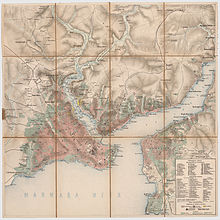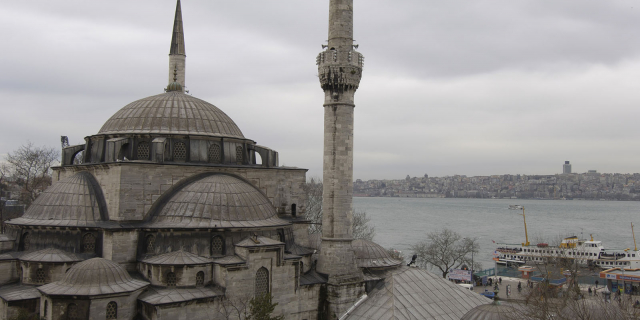Üsküdar (Turkish pronunciation: [ysˈcydaɾ]) is a municipality and district of Istanbul Province, Turkey. Its area is 35 km2, and its population is 524,452 (2022). It is a large and densely populated district on the Anatolian (Asian) shore of the Bosphorus. It is bordered to the north by Beykoz, to the east by Ümraniye, to the southeast by Ataşehir and to the south by Kadıköy; with Karaköy, Kabataş, Beşiktaş, and the historic city center of Fatih facing it on the opposite shore to the west. Üsküdar has been a conservative cultural center of the Anatolian side of Istanbul since Ottoman times with its numerous historic landmark and little mosques and dergahs.
Üsküdar is a major transport hub, with ferries to Eminönü, Karaköy, Kabataş, Beşiktaş and some of the Bosphorus suburbs. Üsküdar is a stop on the Marmaray rail service at the point where it starts its journey under the Bosphorus...Read more
Üsküdar (Turkish pronunciation: [ysˈcydaɾ]) is a municipality and district of Istanbul Province, Turkey. Its area is 35 km2, and its population is 524,452 (2022). It is a large and densely populated district on the Anatolian (Asian) shore of the Bosphorus. It is bordered to the north by Beykoz, to the east by Ümraniye, to the southeast by Ataşehir and to the south by Kadıköy; with Karaköy, Kabataş, Beşiktaş, and the historic city center of Fatih facing it on the opposite shore to the west. Üsküdar has been a conservative cultural center of the Anatolian side of Istanbul since Ottoman times with its numerous historic landmark and little mosques and dergahs.
Üsküdar is a major transport hub, with ferries to Eminönü, Karaköy, Kabataş, Beşiktaş and some of the Bosphorus suburbs. Üsküdar is a stop on the Marmaray rail service at the point where it starts its journey under the Bosphorus, re-emerging on the European side at Sirkeci. Via Marmaray, Üsküdar is linked to Gebze on the Asian side of the city and Halkali on the European side. Üsküdar is also a stop on the M5 Metro line to Çekmeköy. Buses run along the Bosphorus shore all the way up north to Anadaolu Kavağı in Beykoz district. A bus service also operates to the summer town of Şile on the Black Sea.
Üsküdar started as Chrysopolis (Greek: Χρυσόπολις, 'Golden City') and later became known as Scutari (Skoutàrion, Σκουτάριον in Greek), a name it retained until the founding of the Turkish Republic. Scutari was also used for the Albanian city Shkodër, which has a different etymology.
Üsküdar was founded in the 7th century BC by ancient Greek colonists from Megara a few decades before Byzantium was founded on the opposite shore.[1] It was originally called Chrysopolis (Greek: Χρυσόπολις, 'Golden City'). According to an ancient Greek geographer, the city received the name Chrysopolis because the Persian empire had a gold depository there or because it was associated with Agamemnon and Chryseis' son, Chryses.[2] On the other hand, according to an 18th-century writer, it received the name because of the excellence of its harbor.[3] The city was used as a harbor and shipyard and was an important staging post in the wars between the Greeks and Persians. In 410 BC Chrysopolis was taken by the Athenian general Alcibiades, and the Athenians used it thenceforth to charge a toll on ships coming from and going to the Black Sea.[2] Long overshadowed by its neighbor Chalcedon during the Hellenistic and Roman period, it maintained its identity and increased its prosperity until it surpassed Chalcedon.[1] Due to its less favorable location with respect to the currents of the Bosporus, however, it never surpassed Byzantium.[1] In AD 324, the final battle between Constantine I, Emperor of the West, and Licinius, Emperor of the East, in which Constantine defeated Licinius, took place at Chrysopolis.[1] When Constantine made Byzantium his capital, Chrysopolis, together with Chalcedon, became suburbs.[1] Chrysopolis remained important throughout the Byzantine period because all trade routes to Asia started there, and all Byzantine army units headed to Asia mustered there.[1] During the brief usurpation of the Armenian general Artabasdos, his eldest son, Niketas, was defeated with his forces at Chrysopolis by the army of Constantine V, before Artabasdos was finally deposed by the legitimate emperor Constantine and blinded. For this reason, and because of its location across from Constantinople, it was a natural target for anyone aiming at the capital.[1] Also, in the 8th century AD it was taken by a small band of Arabs, who caused considerable destruction and panic in Constantinople, before withdrawing.[1] In 988, a rebellion that nearly toppled Basil II began in Chrysopolis, before he was able to crush with the aid of Russian mercenaries.[1]
Skoutarion, Scutari Under the Ottomans, Scutari was a large neighborhood with many cemeteries, across the water from Constantinople (map by Joseph von Scheda, 1860–70).
Under the Ottomans, Scutari was a large neighborhood with many cemeteries, across the water from Constantinople (map by Joseph von Scheda, 1860–70).In the 12th century, the city changed its name to Skoutarion (Greek: Σκουτάριον), the name deriving from the Emperor's Skoutarion Palace nearby.[1] In 1338 the Ottoman leader Orhan Gazi took Skoutarion, giving the Ottomans a base within sight of Constantinople for the first time.[1] In the Ottoman period Üsküdar was one of the three communities outside the city walls of Constantinople (along with Eyüp and Galata). The area was a major burial ground, and today many large cemeteries remain, including Karacaahmet Mezarlığı, Bülbülderesi Mezarlığı, and a number of Jewish and Christian cemeteries. Karacaahmet Mezarlığı is one of Istanbul's largest cemeteries. The Bülbülderesi cemetery is next to Fevziye Hatun mosque.[4] The neighborhood suffered during the ethnic-religious violence of the 6 September 1955, Istanbul pogrom. Turkish rioters looted Greek and Armenian Christian shops and many Greeks and Armenians subsequently fled the country.[5][6][7]
Üsküdar today The waterfront of Üsküdar as seen from Kandilli Pier
The waterfront of Üsküdar as seen from Kandilli PierThe district of Üsküdar is one of Istanbul's oldest-established residential areas. It is directly opposite the old city of Eminönü and transport across the Bosphorus is easy by boat or bridge. So there are well-established communities here, many retired people, and many residents commute to the European side for work or school (being cheap and central Üsküdar has a large student population). During the rush-hour, the waterfront is bustling with people running from ferryboats and motorboats onto buses and minibuses. The Çamlıca Hill is a popular picnic spot for many Istanbul residents.
 Mihrimah Sultan (İskele) Mosque in Üsküdar
Mihrimah Sultan (İskele) Mosque in ÜsküdarThe central square is the center of Üsküdar with departing ferries and a Marmaray station adding to the importance of the square. The area behind the ferry dock is a busy shopping district, with many restaurants (including the well-known Kanaat Lokantası serving Ottoman cuisine, olive oil-based dishes, and ice cream) and a number of important Ottoman mosques (see section below). However, there are relatively few cafes, cinemas, billiard halls, and places for youth to congregate.[citation needed] The private Üsküdar University, founded by the Human Values and Mental Health Foundation, has a campus here. Uskudar has two public libraries: Şemsi Pasha Mosque Public Library (built in 1953) and Selimiye Public Library.
































Add new comment